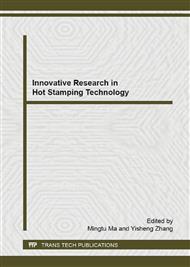[1]
A. Turetta, S. Bruschi, A. Ghiotti. Investigation of 22MnB5 formability in hot stamping operations. Journal of Materials Processing Technology, 2006, 177: 396~400.
DOI: 10.1016/j.jmatprotec.2006.04.041
Google Scholar
[2]
Eriksson M, Oldenburg M, Somani MC, et al. Testing and evaluation of material data for analysis of forming and hardening of boron steel components. Modeling Simu. Mater. Sci. Eng., 2002, 10: 277~294.
DOI: 10.1088/0965-0393/10/3/303
Google Scholar
[3]
A. Barcellona, D. Palmeri. Effect of Plastic Hot Deformation on the Hardness and Continuous Cooling Transformations of 22MnB5 Microalloyed Boron Steel. Metallurgical and Materials Transactions, May 2009, 40A: 1160.
DOI: 10.1007/s11661-009-9790-8
Google Scholar
[4]
Shan Zhong-de, Zhang Mi-lan, Jiang Chao, et al.Basic study on Die Cooling System of Hot Stamping Process[J].Proceedings of the International Conference on Advanced Technology of Design and Manufacture,2010,65-68.
DOI: 10.1049/cp.2010.1248
Google Scholar
[5]
Naderi M, Ut haisangsuk V, Prahl U, et al. A numerical and experimental investigation into hot stamping of boron alloyed heat treated steels. Steel Research International, 2008, 79(2): 77~84.
DOI: 10.1002/srin.200806320
Google Scholar
[6]
Chao Jiang, Zhongde Shan, Bailiang Zhuang, et al.Hot stamping die design for vehicle door beams using ultra-high strength steel[J].International Journal of Precision Engineering and Manufacturing,2012,13(7):1101-1106.
DOI: 10.1007/s12541-012-0144-x
Google Scholar
[7]
M. Merklein, J. Lechler. Investigation of the thermo-mechanical properties of hot stamping steels. Journal of Materials Processing Technology, 2006, 177: 452~455.
DOI: 10.1016/j.jmatprotec.2006.03.233
Google Scholar
[8]
Xu XiaoRong, Sachs Emanuel, Allen Samuel. The design of conformal cooling channels in injection molding tooling[J]. Polymer Engineering and Science, 2001, 41(7): 1265-1278.
DOI: 10.1002/pen.10827
Google Scholar
[9]
Shan Zhong-de, Ye Yong-sheng, Zhang Mi-lan, et al.Hot-Stamping Die-Cooling System for Vehicle Door Beams[J].International Journal of Precision Engineering and Manufacturing,2012,14(7):1251-1255.
DOI: 10.1007/s12541-013-0170-3
Google Scholar
[10]
Dimla D E, Camilotto M, Miani F. Design and optimization of conformal cooling channels in injection moulding tools[J]. Journal of Materials Processing Technology, 2005, 164(7):1294-1300.
DOI: 10.1016/j.jmatprotec.2005.02.162
Google Scholar
[11]
Jacobs P F. New frontiers in mold construction: high conductivity materials and conformal cooling channels[J]. Society of Manufacturing Engineers technical paper, 1999, 5): 99-115.
DOI: 10.1115/imece2000-1833
Google Scholar
[12]
Engels H., Schalmin O., Muller-Bollenhagen C. Controlling and monitoring the hot stamping process of boron-alloyed heat treated steels. New developments in sheet metal forming, IFU, Stuttgart: 135~150.
Google Scholar


